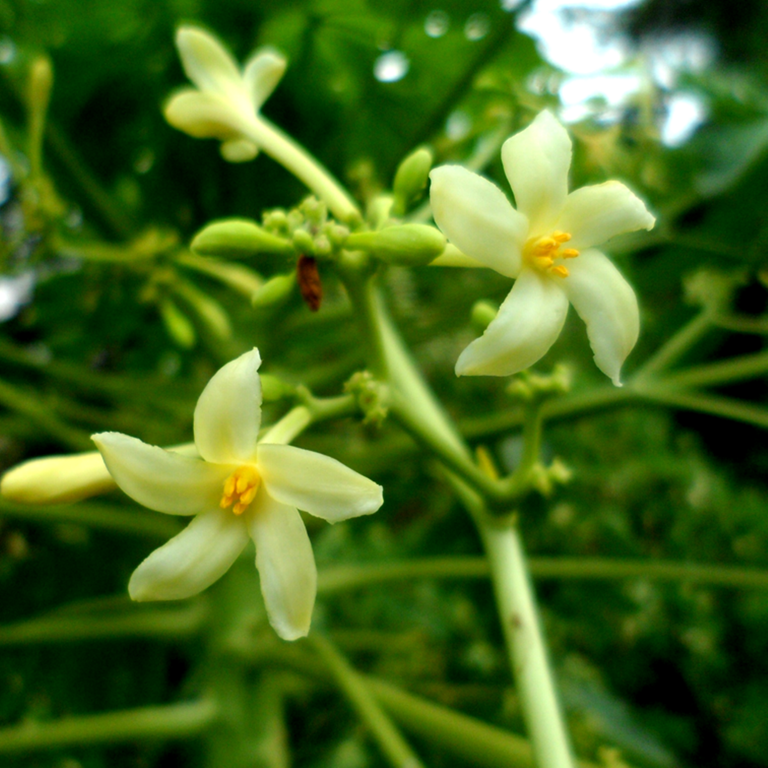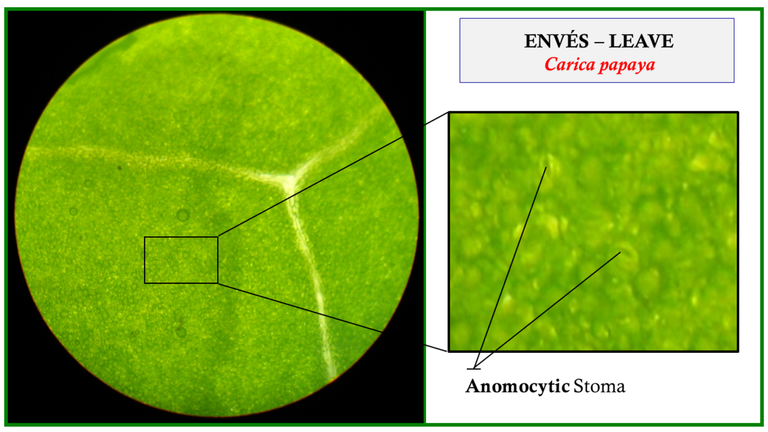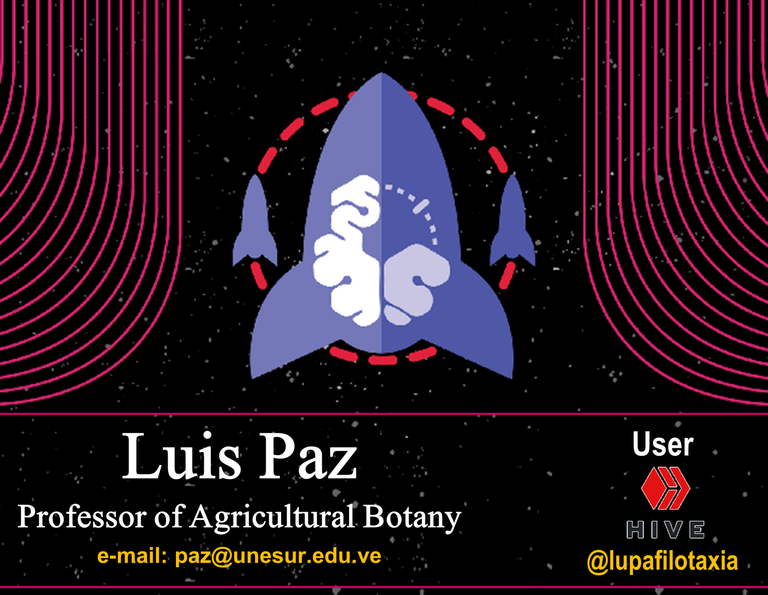
As the previous publications, the content expressed in this manuscript has the purpose of increasing the organographic and histological botanical resources, in this opportunity of the vegetal species Carica papaya (CARICACEAE), the technical-scientific material is supported by unpublished images with the objective of presenting biological details of this important vegetal resource of food interest.
Introduction
Within the genus Carica, the species C. papaya is considered like one of the arborescent biotypes of perennial condition, more appreciated in the tropical countries, mainly by the organoleptic and nutritional characteristics of its exotic fruits type berries, of there that, exist in South America near 65,000 has cultivated with commercial aims, standing out Brazil, Peru, Venezuela and Colombia like the greater producers of the region.
According to records socialized by FAO, the cultivated areas of Carica papaya in these South American countries, generate in average 45 tons of fruit/hectare, material that is destined in a high percentage to fresh or processed consumption (drinks, syrups among others), however, sectors like the cosmetological usually use the seeds of C. papaya in the elaboration of soaps, on the other hand, the latex secreted by its vegetative structures, is widely used by the pharmaceutical industry, basically by the toxic and insecticide effect that provides this vermicidal substance on intestinal parasites.
Consequently, starting from the multiple agricultural and pharmacological utility that offers the Carica papaya, the objective of this post consists of describing the main nutritional properties, organographic and histological characteristics of this valuable biological resource.
Biological classification
Kingdom: Plantae
Division: Magnoliophyta
Class: Magnoliopsida
Orde: Brassicales
Family: Caricaceae
Gender: Carica
Species: papaya
Common names
Carica papaya, is invariably known as Lechosa, however, in countries like Mexico it is designated Papaya, Tree Melon in Cuba, and Mamao in Brazil.
Nutritional properties
Independently of the commercial variety of Carica papaya, it has been reported that its fruits are a rich biological source in vitamin A, vitamin C, niacin, thiamin, riboflavin, in addition to minerals like; calcium, phosphorus, iron, potassium, without forgetting to mention, the high content of carbohydrates and moderate values of fat, fiber and total ash, regarding dampness, is considerably high near 90%, element that positions the fruits of C. papaya within the most consumed fleshy fruit trees in fresh state.
On the other hand, the fruits of Carica papaya, are also characterized for presenting compounds with antioxidant capacity, among these; lycopene, L-ascorbic acid and β-carotene, besides high values of Papain, proteolytic enzyme that is obtained from the latex that fruits and vegetative structures segregate, generally used in the food and pharmaceutical industry.
Origin and distribution
Carica papaya, is original of Mesoamerica, its distribution is of Pantropical character, aspect that has allowed its naturalization in Africa and Asia.
Botanical description
Way of life
The milky one as it is distinguished in Venezuela, possesses a biotype of condition arbustiva, biannual to perennial.
Root
Specimens of Carica papaya, exhibit a pivoting root system with well-developed roots, which can reach up to 1.5 meters in depth.
Stem
It has stems of cylindrical morphology, of hollow aspect except in the knots, semi-woody consistency and bark with abundant latex.

Fig. 2 Cylindrical stem of Carica papaya. Author: @lupafilotaxia.
Leaf
The foliar laminae of Carica papaya, are of peciolated insertion, composed of palmed type, with lobed morphology, lobed edge, aristate apex, hasted base, palmatinervia rib and alternate phyllotaxy.

Fig. 3 Palmate leaf blade composed of palmatinervia rib of Carica papaya. Author: @lupafilotaxia.
Flower
The specimens of Carica papaya, are characterized for exhibiting unisexual flowers either; stepped or staminated, however, they also have bisexual flowers, with calyx and corolla of tubular morphology, and units of white-cream or yellow-orange coloration.

Fig. 4 Floral units of Carica papaya. Author: @lupafilotaxia.
Fruit
Carica papaya, has fruits type berries, of fleshy consistency, succulent, with rounded, tubular or ellipsoidal morphology, of variable coloration when maturing between green-yellow, green-orange and green-red.

Fig. 5 Fruits type berries of Carica papaya. Author: @lupafilotaxia.
Seeds
It has seeds of spherical morphology, of gelatinous consistency, covered by a mucilaginous layer and with present endosperm.
Reproduction
Sexual reproduction
The wild specimens of Carica papaya, present a dioecious sexual reproduction system, nevertheless, the commercial specimens are characterized by exhibiting varied systems of sexual reproduction, among these; monoico, hermaphrodite or polygamy.
Asexual reproduction
Carica papaya, presents vegetative regeneration by propagation by cuttings, this type of asexual reproduction is of vital economic importance in this fruit species, because it allows to select and to multiply resistant materials to diseases.
Growth
The specimens that grow in natural ecosystems, exhibit limited productive development with estimated longevity of 10 years, with respect to the vegetative growth is fast in the first months, with elongations that oscillate between 1 and 2 m after the first year of phenological age, however, with respect to commercial specimens, these can produce fruits for more than 20 years, as long as adequate agronomic management conditions are provided (fertilization, irrigation, control of arvenous species and defoliation of adult laminae).
Ecology
Both the wild and commercial materials of Carica papaya, are characterized for presenting their maximum reproductive potential in tropical climates of isothermal condition, where the climatological oscillations are located preferably to average temperatures of 26 °C, precipitations over 2.400 mm per year, clayey soils with pH over 6 and slightly humidified.
Histology and organography
Microscopic study
In order to extend the existing information, it was developed a histological study on the vegetative structures of Carica papaya, using the optical microscope for the morphological characterization at tissue level, which was executed in the Botanical Laboratory of UNESUR - Venezuela.
Collection
The vegetative material of Carica papaya, was collected from the cultivation area of the Botanical Garden of the Universidad Nacional Experimental Sur del Lago - UNESUR, university institution located in Santa Bárbara, Colón municipality, biogeographic zone of the South of Maracaibo Lake - Venezuela.
Histological identification
The vegetative structures of Carica papaya, were placed in containers with water to guarantee the turgidity of the tissues, later they were transferred to the laboratory facilities of Botany of the UNESUR.
Materials and reagents used
- Vegetative structures of Carica papaya
- Carrier sheets and coverslips
- Botanical dissection team
- Petri dishes
- Optical microscope
- Distilled water
- Lugol
- Safranin
- Floroglucin
Tissue observation
The histological structures of Carica papaya, were observed using OPTIKA brand microscopes, for the identification of epidermal tissue, photosynthetic mesophilic, there were carried out transversal, longitudinal and tangential cuts to the leaves (both faces), first it was focused to 4x to locate tissues and then it was changed to 10x, for its morphological characterization.
For the observation of xylem conduction and phloem tissues, cross sections were made to petioles of Carica papaya.
Histological results
Epidermal characterization
The foliar laminae of Carica papaya, have adaxial and abaxial epidermis of uniestratified morphology, this indicates, that histologically they are constituted by a single cellular layer in each segment, of rectangular and transparent aspect.

Fig. 6 On the right side, there are detailed cross sections of foliage of Carica papaya, on the left side there is the histological description. Author: @lupafilotaxia.
Stomatic characterization
According to the observations made, it was found disposition Hypostomatic in the analyzed foliar segments, this indicates that the stomas are located only in the back (inferior segment) of the foliar laminae of Carica papaya, in relation to the morphology of the stoma was determined of type anomocytic, small, sunken and of elongated aspect.

Fig. 7 On the left side, tangential cut of the leaf underside of Carica papaya, on the left side are shown anomocytic stomas. Author: @lupafilotaxia.
Parenchymal characterization
Regarding the parenchymal tissue of Carica papaya, we observed foliar laminae with dorsal mesofile, with palisade cells in uni-stratified form and pluri-stratified spongy tissue, constituted by four histological layers.
Xylematic and phloematic characterization
The petioles of Carica papaya, are of hollow morphology, this indicates that they do not present central marrow, from there the reason that the medular tissue is visibly developed in the first histological layers, mainly by colenquimatic and parenquimatic tissue, whereas the vascular bundles are observed forming a ring well developed within the base tissuel.

Fig. 8 On the right side, it is detailed cross section of the petiole of Carica papaya, on the left side it is indicated histological description. Author: @lupafilotaxia.
SCIENTIFIC CONTRIBUTIONS OF THIS PUBLICATION
- The morphological characterization determined by observation in situ, and the utilitarian elements, socialized in the present post, include nutritional, organographic and histological data that the fruit species Carica papaya, stands out among; fruits type berries rich in vitamin A, vitamin C, niacin, thiamine, tiboflavin, calcium, phosphorus, iron, potassium, high values of papain, cylindrical morphology stems and semi-yellowish consistency, palmed type foliar laminae and lobed morphology, unisexual pistilized, staminated or bisexual flowers, seeds covered by mucilaginous layer, Histological segments with adaxial and abaxial epidermis of uni-stratified morphology, stomas with hypostomatic and anomocytic disposition, dorsal mesofile, palisade parenchyma in uni-stratified form, pluri-stratified spongy tissue, petioles without central marrow and vascular bundles forming a well-developed ring within the fundamental tissue.
BIBLIOGRAPHICAL REFERENCES CONSULTED AND CITED:
[1] Silva J., Rodriguez W. Ruas H., Paixão J., Machado J., Cabrera J., Schaffer. B., Cuevas J., and Campostrini E. Light, photosynthetic capacity and growth of papaya (Carica papaya L.): a short review. Article: Online access
[2] Campostrini E., and Glenn D. Ecophysiology of papaya: a review. Braz J Plant Physiol. 2007; 19: 413-424. Article: Online access
[3] FAO. Estadísticas agrícolas de Carica papaya a nivel mundial. FAOSTAT. 2017. Platform access
[4] Gunes E., and Gübbük H. Growth, yield and fruit quality of three papaya cultivars grown under protected cultivation. Fruits. 2011; 67; 1: 23. Article: Online access
[5] Zunjar V., Mammen D., and Trivedi B. Pharmacognostic, physicochemical and phytochemical studies on Carica papaya Linn. leaves. Pharmacognosy J. 2011; 3; 20: 5-8. Article: Online access
ATTENTION
Readers and followers
If you wish to read more scientific articles in English or Spanish, of excellent academic quality, do not hesitate to visit #STEMSocial and #STEM-espanol, communities that promote scientific content mainly in the areas of Science, Technology, Engineering and Mathematics.

#Posh Twitter:
Congratulations, your post has been upvoted by @dsc-r2cornell, which is the curating account for @R2cornell's Discord Community.
Thank @dsc-r2cornell for your constant support to the blog.
Thanks for your contribution to the STEMsocial community. Feel free to join us on discord to get to know the rest of us!
Please consider supporting our funding proposal, approving our witness (@stem.witness) or delegating to the @stemsocial account (for some ROI).
Please consider using the STEMsocial app app and including @stemsocial as a beneficiary to get a stronger support.
Thank you team for your constant support to the blog.
Congratulations @lupafilotaxia! You have completed the following achievement on the Hive blockchain and have been rewarded with new badge(s) :
You can view your badges on your board and compare yourself to others in the Ranking
If you no longer want to receive notifications, reply to this comment with the word
STOPDo not miss the last post from @hivebuzz:
Thank you for this message, full of information that motivates us to continue working with the same dedication and energy of the beginning.
Dear @lupafilotaxia,
Thank you for this interesting article. This is obviously an important food source for millions of people. I notice that latex is found in the stems and fruit. Is this not a potential issue for latex-sensitive people? Also, I have recently been reading about caterpillars, and remember that monarchs eat milkweed, which has latex and this makes the caterpillar noxious to predators. Are there caterpillars that are specific to the carica papaya plant?
I hope you and your family are well and peaceful in these tumultuous times. You always produce articles that expand our understanding of the plant world.
Regards,
AG
Greetings amgio @agmoore, even though it is not common for people to get intoxicated, if there are side effects and allergic contraindications related to latex secreted by the milky fruits, however, the problems it usually causes are irritations in the esophagus, but these only occur when the fruit is consumed without removing the epicarp (shell) which is a region with a high concentration of latex.
As for which is the specific caterpillar of the Carica papaya, I comment you that in this zone, generally the effects are generated by a lepidopterous of the genus Erinnyis, usually attacks the foliar laminae I estimate by the serious damages that it causes, that probably the papain enzyme does not affect this species of caterpillar, taking into account that the papain is the substance of greater concentration reported in the latex of the milky.
Thank you for your blessings, may they be replicated for you and yours.